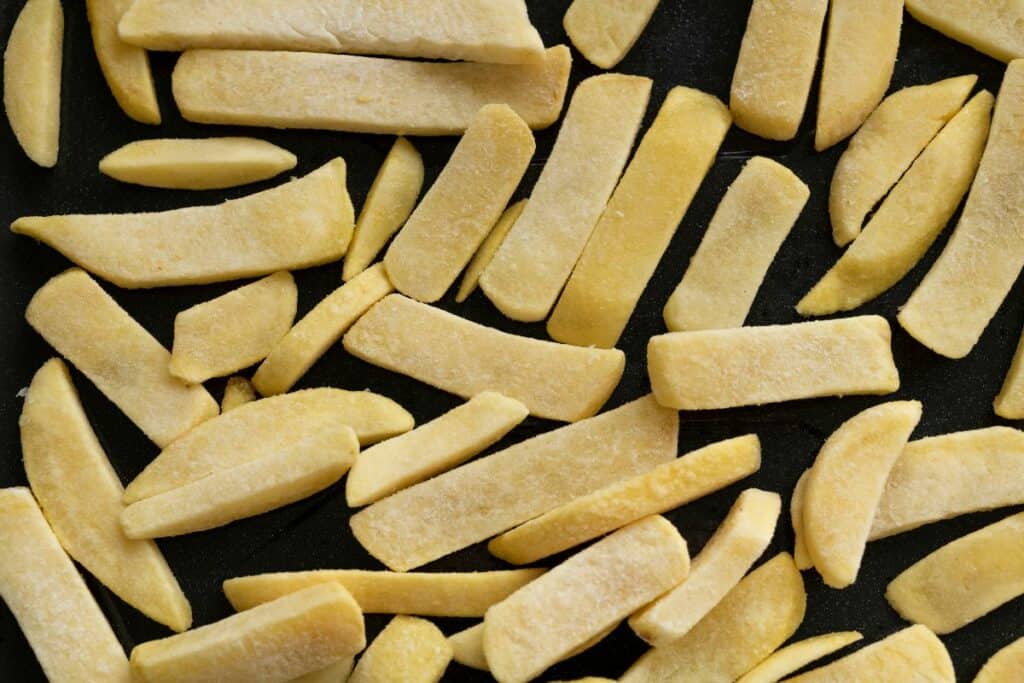If you’ve ever tried making oven chips at home, you may have been disappointed with the results. Despite your best efforts, your chips may have come out tasting bland, dry, or even burnt. So why do oven chips taste bad?
One reason is that oven chips lack the texture and flavor that come from deep frying. When you fry potatoes in oil, the high heat causes the moisture inside the potato to turn into steam, creating a crispy exterior and a fluffy interior. In contrast, oven-baked chips don’t get hot enough to create this effect, resulting in a less satisfying texture.
Another factor is the type of potato used. Some varieties of potato are better suited for frying than for baking, and vice versa. Oven chips are typically made from drier, starchier potatoes that don’t hold up as well to the high heat of frying. This can result in a less flavorful chip that lacks the rich, buttery taste of a deep-fried chip.

Why Do Oven Chips Taste Bad
When you decide to cook oven chips, you expect them to be crispy and delicious. However, sometimes they come out soggy, bland, or just plain bad. Here are a few reasons why oven chips may taste bad:
- The temperature is too low: If the oven temperature is too low, the chips will not cook evenly and will come out soggy. Make sure you follow the cooking instructions on the package and preheat the oven to the correct temperature.
- The chips are overcrowded: If you put too many chips on the baking tray, they will not cook evenly and will come out soggy. Spread the chips out on the tray so that they have enough space to cook properly.
- The chips are not seasoned: Oven chips can be bland if they are not seasoned properly. Sprinkle some salt, pepper, and other seasonings on the chips before cooking to add flavor.
- The chips are not cooked long enough: If you take the chips out of the oven too early, they will not be crispy and will taste undercooked. Make sure you leave them in the oven for the recommended cooking time.
- The chips are not turned over: If you do not turn the chips over halfway through cooking, they will not cook evenly and will come out soggy. Turn them over with a spatula to ensure they cook evenly on both sides.
By avoiding these common mistakes, you can make sure your oven chips come out crispy and delicious every time.
The Science Behind Oven Chips
When it comes to making oven chips, there are a few key factors that can impact their taste and texture. Understanding the science behind these factors can help you make perfect oven chips every time.
Potatoes
The type of potato you use can make a big difference in the taste and texture of your oven chips. Russet potatoes are a popular choice because they are high in starch and low in moisture, which makes them crisp up nicely in the oven. However, other varieties like Yukon Gold or red potatoes can also work well. Just be sure to choose potatoes that are firm and free of blemishes or sprouts.
Salt
Adding salt to your oven chips can enhance their flavor, but it’s important not to overdo it. Too much salt can make your chips taste overly salty and can also cause them to become soggy. A light sprinkle of salt before baking is all you need. You can also experiment with other seasonings like garlic powder, paprika, or rosemary to add extra flavor.
Fat
The type of fat you use to cook your oven chips can also impact their taste and texture. While some recipes call for vegetable oil or canola oil, others recommend using olive oil or even butter. Each type of fat has its own unique flavor and smoking point, so it’s important to choose the right one for your recipe. Just be sure not to use too much fat, as this can cause your chips to become greasy and heavy.
One thing to keep in mind is that oven chips are often lower in fat than traditional fried chips, which can impact their taste and texture. While this can be a healthier option, it’s important to manage your expectations and understand that oven chips may not taste exactly like their fried counterparts.
Another factor to consider is acrylamide, a chemical that forms when certain foods are cooked at high temperatures. Acrylamide has been linked to cancer in animal studies, but its impact on human health is still being studied. To minimize your exposure to acrylamide, try to avoid overcooking your oven chips and use lower cooking temperatures whenever possible.
Cooking Methods for Oven Chips
Cooking Techniques
When it comes to cooking oven chips, there are a few techniques you can use to improve their taste and texture. First, make sure to preheat your oven to the correct temperature as specified on the packaging. Toss the chips in a small amount of vegetable oil or corn oil, just enough to lightly coat them. Spread them out evenly on a baking sheet, making sure they are not overcrowded. This will help them cook evenly and become crispy.
Oil Choices
Choosing the right oil is also important when cooking oven chips. Vegetable oil and corn oil are both good choices, but if you’re looking for a healthier option, try using sunflower oil. It has a higher smoke point than vegetable or corn oil, which means it can be heated to a higher temperature before it begins to smoke. This will help reduce the amount of oil absorbed by the chips, making them a healthier choice with fewer calories and less sodium.
Baked Chips vs. Fried Chips
Baked chips are a healthier option than fried chips, but they can often lack the crispy texture of their fried counterparts. If you’re looking for a healthier option, try baking your chips instead of frying them. To get that crispy texture, try using the technique described above, and make sure to spread them out evenly on the baking sheet. If you’re looking for a more indulgent option, frying your chips in a small amount of oil can give them that crispy texture you crave.

Reducing the Amount of Oil
If you’re concerned about the amount of oil your oven chips are absorbing, there are a few things you can do to reduce it. First, try tossing them in a small amount of oil instead of pouring it on. Second, make sure to drain any excess oil from the chips before serving. Finally, try using a non-stick baking sheet or lining your baking sheet with parchment paper to reduce the amount of oil needed.
In conclusion, there are several techniques you can use to improve the taste and texture of your oven chips. Choosing the right oil, using the correct cooking techniques, and reducing the amount of oil can all help you make healthier, tastier oven chips.
Making Your Oven Chips Crispy and Delicious
Baking Tray and Seasoning
To make your oven chips crispy and delicious, start by using a baking tray that is not overcrowded. Overcrowding reduces the temperature of the oil that the chips are baking in, giving them even less chance to crisp up. Also, make sure to season your chips with salt, pepper, and any other desired seasonings before baking.
Checking for Crispiness
To check if your oven chips are crispy enough, remove them from the oven and give them a gentle shake. If they are not quite crispy enough, return them to the oven for a few more minutes. You can also try flipping them over halfway through the baking process to ensure that both sides are crispy.
Frozen Chips and Coating
If you are using frozen chips, make sure to follow the instructions on the packaging for the best results. Some frozen chips come with a dextrose or sugar coating that helps them crisp up in the oven. However, be aware that this coating can also affect the appearance of your chips.
Overall, making oven chips crispy and delicious requires proper baking techniques and seasoning. With the right baking tray, seasoning, and checking for crispiness, you can enjoy perfectly crispy and delicious oven chips every time.
Understanding Oven Chip Labels
Ingredients and Nutritional Information
When you’re looking at the label of your favorite brand of oven chips, it’s important to pay attention to the ingredients list and nutritional information. Oven chips can contain a variety of ingredients, including potatoes, vegetable oil, and added seasonings. Some brands may also use beef dripping or other animal fats for flavor.
When it comes to nutritional information, be sure to check the serving size and number of servings per container. Pay attention to the calories, fat, and sodium content, as well as any other nutrients that are important to you. Keep in mind that some oven chips may be higher in calories and sodium than others.
Health Considerations
While oven chips can be a convenient and tasty snack or side dish, it’s important to consider the potential health implications. One concern is the presence of acrylamide, a chemical that can form when certain foods are cooked at high temperatures. Acrylamide has been linked to an increased risk of cancer in animal studies, but more research is needed to determine its effects on humans.
Another consideration is the use of beef dripping or other animal fats in some brands of oven chips. These types of fats can be high in saturated and trans fats, which can increase your risk of heart disease and other health problems. If you’re concerned about your health, look for oven chips made with vegetable oils or other healthier fats.
Conclusion
You now understand why oven chips often taste bad. While they may be a convenient and healthier alternative to traditional fried chips, they lack the texture and flavor that make chips so enjoyable. The main reasons for their inferior taste are the lack of proper browning and the use of batter instead of oil.
When you want to enjoy the best possible chips, consider making them yourself at home using fresh potatoes and a deep fryer. This will allow you to achieve the perfect balance of crispiness and fluffiness, and to season them to your liking. If you don’t have a deep fryer, you can still make delicious chips by frying them in a pan with plenty of oil.
Remember that the quality of your potatoes and oil will also affect the taste of your chips. Ideally, you should use a high-starch potato variety such as Russet, and a neutral oil such as vegetable or canola oil. Avoid using olive oil or other flavored oils, as they can overpower the taste of the potatoes.
Finally, don’t be afraid to experiment with different seasonings and dipping sauces to enhance the flavor of your chips. Some popular options include salt and vinegar, garlic and herb, and spicy ketchup. With a little bit of practice and creativity, you can make the perfect chips that will satisfy your cravings every time.




